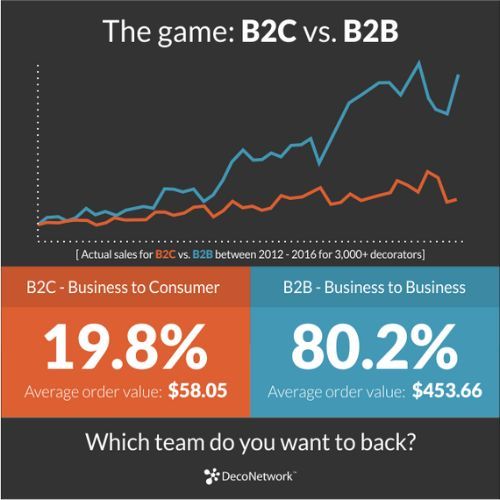In this article, Team Pollen writes about the difference between B2B and B2C trading and how Pollen plays a role in facilitating sustainability for all.
From the Ever Given capturing headlines when it blocked the Suez Canal, to empty shelves in supermarkets, to rising prices across the board - the COVID-19 pandemic brought online shopping and its accompanying supply chains to the fore.
While most of us are familiar with B2C (business-to-consumer) trading, recent news cycles are beginning to increase awareness of the B2B (business-to-business) marketplace going on behind the scenes of our favorite retail brands.
So what are the key differences, and why does Pollen care?
"The global B2B eCommerce market valuing US$14.9 trillion in 2020 is over 5 times that of the B2C market." - Statista In-Depth Report: B2B e-Commerce 2021
B2B marketplace trading encompasses a wide range of product and services, some outside the consideration of individual consumers. For example, it brings raw materials to manufacturers, manufactured goods to distributors and wholesalers, and wholesale goods to retailers (after which B2C marketplace trading may kick in, from retailer to consumer).
In a nutshell, the key differences between B2B and B2C trading are:
Volume
B2B marketplace trades involve large quantities of raw materials or manufactured goods.
Value
As can be seen from the graph on the right, the value of B2B transactions significantly outweighs that of B2C transactions, thanks to the volume of each transaction.
Logistics
Since B2B trades involve larger volumes of shipments, the process tends to be costlier, more time-consuming, and may involve special handling equipment or specialized operators.
Speed
As mentioned above, the B2B process tends to require more time when shipping products. But the overall decision cycle takes longer than in B2C too. This may happen because of different reasons, such as costs, processes, and strategy.
For instance, deciding between buying a $5 bottle of shampoo or a $5 million shipment of shampoo would require different levels of consideration. Also, when a business needs to make a decision, various departments and documentation are usually involved in the decision-making process.
Furthermore, the decision may be influenced by the company's strategy, such as expanding into new markets or deciding which product lines to focus on.
Many of us are used to same-day shipping of items for personal use but rarely do businesses expect their shipments of containers filled with products for sale to be delivered the next day (let alone the same day).

Source: deconetwork.com
Marketing
While B2B and B2C marketing essentially deal with people and observe the same funnels (awareness, interest, consideration, intent, evaluation, purchase), B2B marketing may focus more heavily on product demos, industry whitepapers, case studies, and reviews.
Not only that, the websites of B2B trading platforms and B2C companies tend to differ in look and feel, user experience, and messaging. For example, a B2C website usually emphasizes the advantages of a product for the consumer, such as "clearer skin in one week!" or promotions like free shipping.
On the other hand, a B2B website tends to offer more extensive details about the product, including reviews, demo videos, free trials, and other content that caters to corporate decision-makers evaluating a significant purchase.
Customer Relations or Assurance
In B2B trades, due to a longer decision-making cycle and the larger volumes & values, customer relations and post-sale service differ from that of B2C's. To start with, a potential or returning customer requires more information and nurturing (see Marketing item above).
The sales process may involve more detailed paperwork and proposals than B2C sales. And finally, while consumers are used to warranties and insurance on purchased products, B2B trades' scale of such assurances is significantly larger due to the volume and value involved.
Sustainability Initiatives
Many of us take steps to do our part for the environment. From refusing single-use plastics, walking or cycling to destinations instead of taking the car, to opting for environmentally friendly products or diets.
When it comes to sustainability initiatives, businesses - and, therefore, B2B trading - have more options than a single individual.
Businesses have many ways to contribute to the community, such as using ethical and eco-friendly practices, recycling or donating excess goods, and finding ways to sell slow-moving inventory. Pollen marketplace offers various options for sustainable liquidation, including their marketplace and network of recycling and donation partners worldwide. If you're in the B2B industry, you can contact Pollen's team to learn more about their liquidation management system and how it can benefit your business. After all, sustainable liquidation is good for business.
"Business-to-business (B2B) is a transaction or business conducted between one business and another, such as a wholesaler and retailer. B2B transactions tend to happen in the supply chain, where one company will purchase raw materials from another to be used in the manufacturing process." - Investopedia
Source: Net Solutions
Want to know more about how Pollen's sustainable liquidation management system or liquidation marketplace can help your excess inventory? Visit https://www.pollen.tech/ to discover more!
Enjoyed this article? Share it with your friends and connections, and subscribe to this blog for more updates about Sustainable Liquidation!


